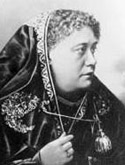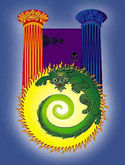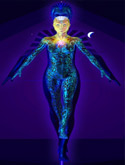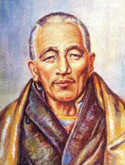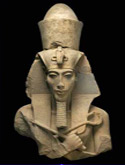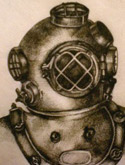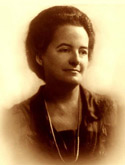Johann Sebastian Bach: Master Composer
March 31, 1685 NS, Eisenach, Germany. Many times are proposed: 5:45 AM, LMT; 9:38 AM (Kraum), 10:58 AM, 12:14 PM, and 2:00 PM, yielding various Ascendants in Aries, Cancer and Leo. The following from LMR illustrates this: Dewey quotes “450 Themes De Musicians.” Kraum spec. 9:38 AM in AA, 2/1963. Eshelman spec. 10:58 AM. PC spec. 12:14 PM. Genuit has 2:00 PM in AQ, Winter/1964, taken from “Astrol Aukunftsbogen”. Died of apoplexy, July 28, 1750, Leipzig, Germany. Michael D. Robbins © 2003.

(Proposed Ascendant, Cancer with Pluto in first house; proposed MC in Pisces; Moon and Neptune conjunct each other and the MC; Mercury and Venus are also conjuncted in Pisces; Mars in Sagittarius conjunct Juno; Jupiter in Libra; Saturn in Virgo; Uranus conjunct Chiron in Taurus; Pluto rising in Cancer). The preferred chart after rectification work is the 9:38 AM chart of Kraum.
Johann Sebastian Bach: the Western World’s Greatest Composer
 Johann Sebastian Bach is considered by many to be the greatest composer ever produced by Western civilization. He was the complete master of his musical craft, and knew the deep secrets of harmony and counterpoint as none before or after him. He knew with unparalleled profundity, the mathematics of music; yet for all his technical/quantitative expertise, he composed music of surpassing beauty and poignancy.
Johann Sebastian Bach is considered by many to be the greatest composer ever produced by Western civilization. He was the complete master of his musical craft, and knew the deep secrets of harmony and counterpoint as none before or after him. He knew with unparalleled profundity, the mathematics of music; yet for all his technical/quantitative expertise, he composed music of surpassing beauty and poignancy.
The soul of Germany is the fourth, and Bach (with Beethoven and Brahms) are the great composers who paramountly express, musically, the soul of their nation. Interestingly, the soul of Germany is also ruled by Aries, Bach’s Sun Sign (and from one account, his Ascendant). Further, his stellium in Pisces (consisting of four major planets – Moon, Neptune, Venus and Mercury), correlates with the personality sign of Germany – Pisces. The constant pouring forth through his music of life energy with its super-abundant vitality is indicated by Aries. Musical receptivity, sensitivity and expertise are indicated by the multiple conjunction in Pisces. The Moon is associated with innate faculty; Neptune (the most ‘musical’ of the planets) with inspiration; Venus with art, aesthetics and beauty; Mercury with acumen and dexterous expression, all found, felicitously, in this sign deeply associated not only with music, but emblematic of the Christ. Bach had a strong relation to all the soft-line rays (two, four and six) and, in some noteworthy manner, to all the hard line rays as well. His indisputable fourth ray conferred his sublime musical artistry – he was the harmonist supreme; ray two gave his comprehensiveness and depth of compassion; ray six bestowed the transcendent devotion expressed through his sacred music – cantatas, masses and oratorios. The third ray produced the incredible fertility and intricacy of his web-weaving mind, and the seventh ray his unparalleled organizational/architectural skills in musical composition (supported by structural Saturn in perfectionistic Virgo), the first ray his remarkable determination and endurance, the fifth ray (found generically in the energy system of those whose attainments take them to the ‘mountain top’ of the third degree) his factual, scientific mastery of all the elements of music.
Finding the Correct Time of Birth
Which is the correct time of birth and, thus, which the correct Ascendant? No recorded time of birth exists for J.S. Bach; only the day is confirmed. Different astrologers will support their hypotheses with plausible arguments. The chart offered by Kraum (9:38 AM, LMT) is most compelling to the author, and he has made the attempt to justify it, or a chart drawn for very nearly the same proposed time, varying perhaps by half a minute. The author does understand, however, how other astrologers may argue reasonably for other times of birth. The proposed chart gives early Cancer rising, with both the exoteric ruler of the Ascendant, the Moon, and the esoteric (and hierarchical) ruler, Neptune, conjunct at the Pisces MC. The potentials for supreme musical receptivity presented by this combination are extraordinary. This conjunction produces the possibility of pure musical intuition, for Neptune is arguably the most ‘musical’ of planets, and Pisces, the most musical of signs. In this case, we can consider the Moon as veiling Neptune. In esoteric astrology, Neptune is also the Christ/Vishnu, and it can be justly said that Bach’s greatest choral works (his St. Matthew Passion, and his B Minor Mass) are deeply Christ-centered. Of course, these two planets (rulers of his chart’s soul indicator – i.e., the Ascendant) also indicate his dharma, his ‘calling’, his vocation, his ‘soul summons’ as master musician.
Two other planets, Mercury and Venus, also demonstrate great musical potential, especially when conjuncted and in Pisces. Being placed in the tenth house, they, too, can be considered dharmic indicators. Further, if a fourth ray soul seeks expression, it will do so either through constellations which carry the fourth ray (and the rulers of these constellations) or through planets which transmit that ray. An elevated fourth ray Mercury conjunct aesthetic Venus, and an elevated fourth ray Moon conjunct Neptune (ruler of the fourth or buddhic place) present just such a channel for the fourth ray. The chart, chosen, therefore, conforms well to nature of Bach’s life and his soul calling. Other charts offer an Aries, Leo or later Cancer Ascendant. According to the author’s reasoning, none of them proves as convincing as the Kraum chart, for a variety of reasons relating to physiognomy, the timing of cycles in the dynamic chart correlated with important events, and the general patterning of the natal chart. Those who are interested, however, are invited to test these other charts to see if they come to different conclusions.
Seeking Confirmation of the Proposed Astrological Chart by Various Means
It is important to seek, by all means, confirmation of the validity of the chart to be used. Perhaps this cannot be done with utter exactitude, as the judgment of the astrologer will always enter the consideration (and astrologers will judge differently, using different criteria which they consider more convincing than the criteria used by other astrologers). Nevertheless, an attempt must be made.
The Testimony of Physiognomy. Portrait of J.S. Bach by D’Haussmann

a. It may be that we cannot entirely rely upon the existing images of J.S. Bach for a true semblance of his face and features. Authenticity is claimed for various portraits, but the two portraits by d’Haussmann have the greatest support. The large image above is the best known and most loved of d’Haussmann’s two portraits and will be used as the principle physiognomic reference. Amongst all the portraits there are certain points of similarity and they will be referenced where indicative. When a given facial feature is similarly portrayed in some or all portraits, it is likely that such a feature was representative of the true image of Bach.
b. The overall aspect of the face is set and strong, reserved, firmly self-contained. Bach’s solid Germanic ancestry is plainly visible as it is in the face of his father Johann Ambrosius Bach (another musician of note).
c. The expression in the eyes of J.S. Bach is wary, alert and intent. Although Bach was on occasion a sociable man, given to a love of hospitality, the essential attitude in the portrait is inward-looking and interiorly attentive.
d. The eyelids slightly cover the eye. This is partially an indication of aging, but also is found with water signs prominent – mostly so in the case of Scorpio (and Taurus, of the earth signs), but also found in Pisces and Cancer. A double fire sign emphasis suggested other proposed charts (namely Sun Aries/Aries Ascendant or Sun Aries/Leo Ascendant) would probably not cause this particular formation of the eyelids.
e. For other reasons as well, the eyes do not suggest a double Aries emphasis. Nor does Bach’s character suggest such a strong Aries emphasis. The eyes also do not suggest a combination of Aries and Leo, for Leo emboldens the eyes and enlarges them. Bach’s Sun, however, is placed in the Leo decanate of Aries (the second decanate) and so this influence does emerge (in one way through his large and high forehead, to which the Leo emphasis contributes especially). The high forehead is also a signature of Sagittarius (orthodoxly ruled by Jupiter which governs the upper forehead, not the lower brow); Mars, the orthodox ruler of the Aries Sun-sign is placed in Sagittarius in the second, or Aries, decanate. Thus, Sagittarius is influential physiognomically – but not so much in relation to the chin (which will be discussed).
f. Rather, the eyes, more retiring, show the influence of water signs and fit much better with the proposed Cancer Ascendant (the exoteric ruler of which, the Moon, is angular in the sign Pisces). When Cancer and Pisces are pronounced in the chart there is often a squinting which occurs around the eyes and, in the case of Cancer, a slightly ‘crabbed’ or ‘crabby’ effect at the outer corners. All proposed charts for Bach, but one, have the Pisces Moon and three planets in water signs. The proposed chart adds to these four the Cancer Ascendant which makes the Moon even more powerful and increases the signatures of Pisces in the face (noticeable in a certain retiring quality about the eyes).
g. The slight ‘puffiness’ of the eyelids and their non-indented descent from the eyebrows relate to Saturn in Virgo, which is in tight aspectual relation to the Aries Sun (the Sun placement being always a strong physiognomic indicator). The Capricorn energy (related to Saturn) can also cause this puffiness, and we note that Saturn is in the Capricorn decanate of Virgo.
h. The earliest chart (for 5:45 AM) can almost certainly be eliminated simply because the Moon is in Aquarius (a sign which does not at all seem to place its imprint upon Bach’s features). In addition, the musical Pisces Moon (found only in the later charts) seems a requirement given the nature and quality of Bach’s music, so much of it ‘religious’ music.
i. We note a certain subtle triangle on the brow over the nose. This is frequently found when Aries is influential. These lines indicate a strong power of concentration and an ajna center focus often found in personally-assertive Aries.
j. The nose is usually of special importance when considering physiognomy. The one noticeable factor in all the various portraits is that the nose points downwards. This is a feature associated with Saturn, Capricorn and Scorpio, and not very often with Aries or Cancer (though sometimes in relation to the second decanate – the Scorpio decanate – of Cancer). Except for the thickness of the lower lip and the shape of the chin, one could almost think that the second decanate of Cancer should be rising, as the Scorpio influence would then be stronger and the inclination of the nose accountable. There are certain cycles of timing, however, which necessitate that the first decanate of Cancer be the rising decanate, and these cycles cannot be easily dismissed).
k. So the inclination of the nose is definitely Saturnian and we need a way to account for this. Fortunately, such a way exists. Saturn, placed in Virgo, is in the Capricorn decanate of Virgo (the decanate, in this case, ruled by Saturn), and Saturn is closely quincunx to the Aries Sun (they are both in the twelfth degree {eleven plus} of their respective signs, and this aspect is only a fraction more than half a degree from exact). This powerful Saturn so closely in aspect with the Sun would probably be sufficient to incline the nose downward (whatever the astro-genetic mechanism by which this influence functions).
It should also be said that when Neptune is strong, the downward pointing nose is also found, and Pluto frequently inclines in this direction also. (Mars, Venus, Jupiter, Mercury and the Moon, unless conditioned by their sign placement, do not.).
l. In the proposed chart, we can see a very strong Neptune – strong because it is angular, conjuncted to the MC, and also conjuncted to the Moon which is the orthodox ruler of the proposed Cancer Ascendant. The two rulers (on all three levels) of Cancer are Neptune and the Moon and they are both in Pisces, angular. The physiognomy, therefore, should be powerfully affected by Piscean features. To the extent that Pisces reflects Neptune rather than Jupiter (and, there are in relation to Pisces, at least these two planetary types of individuals to be noted – perhaps a Plutonian type as will), this inclination of the nose will be a feature. (Generally the esoteric rulers do not so much place their stamp upon the face.)
m. While it cannot be invariably asserted, when the first ray (and the hard-line rays in general) is influential, the nostrils are less visible. The opposite is often true when the soft-line rays influence strongly. There is much evidence that Bach was strongly influenced, in his personality, by the first and seventh rays.
n. We should now focus on the chinalways an important astro-physiognomical indicator. We note, overall, a strong chin. In the various likenesses, the chin is variously portrayed. In the likenesses judged as most authentic (those by d’Haussmann), there is noticeable rounding to the chin (even though the chin can be judged as strong). Other likenesses (painted or sculpted well after the time that Bach was alive) begin to idealize the chin, squaring it and making it more pronounced. The more pronounced and square the chin, the greater the impression of strength and fortitude; obviously this is the impression which later artists sought to portray, allowing, perhaps, the (by then) great reputation of Bach to influence them. The d’Haussmann portraits look altogether more reliable (and also less idealized).
o. The treatment of the chin is very important in determining the correct Rising-sign. The d’Haussmann chins are definitely Cancerian. They are rounded (though pronounced) and there is a definite ‘double chin’ to be noticed – a feature frequently found when Cancer is the Rising-sign (more so in the first and third decanate than in the middle, Scorpio decan). D’Haussmann captured it perfectly, it would seem. Rounded contours tend to confirm the Cancer Ascendant. The thick lower lip is another confirmation which would not usually be found with Leo rising (unless the Cancer influence was prominent) or even with the second decanate of Cancer rising.
p. It is probable that Bach had quite a bit of the first and seventh rays in his nature. The sign/constellation Aries, alone, transmits these rays, and Cancer transmits the seventh. The first ray and seventh ray (together or separately) made the chin more pronounced. The chin is the symbol of endurance upon the physical plane, and the first and seventh rays are naturally suited for endurance (survival) in form.
q. It should be realized that not only astrological factors influence the contour and features of the face; ray factors do as well. The face of Bach carries this first ray/seventh ray stamp – strong, stolid, self-contained, (sometimes called ‘dour’), and stubborn – a quality indicated by the strong chin.
r. Actually, the chin is stronger than we would expect from Bach’s signs and planets alone. Aries is neutral as regards the chin, and the Leo decanate of Aries produces, perhaps, a little stronger chin than the first or third decanates of Aries (ruled by Aries and Sagittarius, respectively). But the orthodox planet, Mars, placed in Sagittarius should definitely weaken the chin. Sagittarius seems to weaken the chin most of any sign. Cancer, Virgo and Pisces (in general, but depending on the decanate) are also involved in weakening the chin. We do notice that Cancer (proposedly) and Pisces (definitely) are very important in Bach’s chart, so there are a number of influences which would contribute to the weakening of the chin.
s. That the chin is reasonably strong (though, frankly somewhat rounded) can be attributed to Bach’s strong first and seventh ray, to the Sun in the Leo decanate of Aries, but most of all to the close aspect of Saturn (in Capricorn’s decanate) to the Sun. Capricorn (contrary to Cancer) strengthens the chin, as does Saturn.
t. Bach’s general portliness is a somewhat hereditary factor, independent of personal astrology, but is also furthered by the opposition of Jupiter (in pleasure loving Libra, in the house of enjoyment, the fifth) to the Sun.
u. The eyebrows should be noted. They move upward from the root of the nose and tend to arch a bit before moving downward again. The initial general inclination of the eyebrows suggests hard-line rays rather than the soft line. (See the physiognomical work of James Davis.) The ‘tented’ eyebrows are frequently found with strong Scorpio. Scorpio is not, however, strong in this chart, but Pluto is rising within twelve degrees of the proposed Ascending degree. The eyebrows, therefore, must be considered as testimony to a strong first ray/seventh ray in the makeup.
v. The considered judgment of the author, is that the d’Haussmann portraits support the astrological chart proposed – with early Cancer rising and a Pisces MC with Moon and Neptune (both in Pisces) conjunct the MC.
The Testimony of the Natal and Dynamic Charts: House Positions, Transits, Progressions and Directions.
Physiognomical studies are an invaluable support for rectifying a chart. If a person does not ‘look like his chart’, something is definitely wrong. Astro-physiognomy is, however, a subtle science and many are the potentially modifying factors. Families, nationalities and racial groups also have their own astrological significators which influence appearance in a general way, and these, of course, must be taken into account. These are factors which often override the astrological significators of the individual; the two should not be confused, but often are. For instance, those in the Oriental races will usually have upper eye lids which come down further over the eye than is the case in the Caucasian group. In the Caucasian group such eyelids are generally associated most strongly with Scorpio and Taurus influence (and justifiably so). If one tries to use the same criteria when examining the physiognomy of Orientals, one may be misled. But could it be that the influence of these two signs (Taurus and Scorpio) is more active in the Oriental races? And similarly, could it be that the energy of the sign/constellation Cancer is more active, in general, in the Black races? Leo, for instance, might be a sign prominent in the Caucasian race with its emphasis on the fifth ray. Racial Astrology is a study for the Manu’s Department, and is, no doubt, a very real discipline of the greatest interest. Back to J.S. Bach. No matter how indicative physiognomical study may be concerning the relative correctness of the chart, the testimony of the cycles is also needed. To this let us now address ourselves. As we study some important life-events, we will also attempt to confirm the validity of the char
The Pattern of the Chart in General
a. First, let us look at the simple conformation of the chart. Does it make sense in terms of what we know of the life circumstances of J.S. Bach? Do the planets in the houses tell a convincing story.
b. We have already discussed, in part, the appropriateness of the sign Cancer as an Ascendant, but there is more to say. We do remember that Bach was a ‘family man’. He fathered (by most accounts) no fewer that twenty children; he was thrifty (he would have to be); he eschewed the opportunity to travel throughout Europe where he would surely have found wealth and fame as an organist and keyboard artist; rather, he preferred the quieter life of the cities in which his duties lay (perhaps he could not easily escape his domestic responsibilities); he was reputed to be a person of great hospitality; he was humble and respectful in his relations with other musicians; he was also defensive and, for some, unapproachable. All these justify the Cancer Ascendant.
c. Neptune and the Moon at the MC are definitely indicative of an almost ‘divine mediumship’ in the realm of music.
d. Mercury and Venus in the tenth house are appropriate to his musical profession.
e. The Sun in the eleventh house suggests his extensive group responsibilities and his many students, as well as vocal and instrumental performers to whom his duties required that he relate.
f. Mars in the sixth house tells of the endless exertions required by the professional positions he assumed, and the zeal with which he approached his duties.
g. Jupiter in the fifth house speaks of his exceptionally abundant outpouring of creativity. On a more tangible level, it is a most suitable position for a man who fathered twenty children.
h. Saturn in Virgo, in the fourth house, tells of the early loss of his parents, as well as the many burdens and responsibilities he faced with his own very large family. It also speaks of the frequent difficulties he experienced in the positions for which he was hired (which always entailed a move to a new city – an increasingly difficult task as his family grew). He was so often at odds with the civic and municipal (fourth house) authorities (Saturn) who were his provincial, parochial, and often unsympathetic supervisors. This Saturn position, as well, tells us why his travels (undertaken mostly to listen to music or to inspect or advise in relation church organs) were confined to a relatively localized area.
i. All in all, the house positions of the planets correlate well with his major types of experiences.
Dynamic Factors Which Indicate High Points in Bach’s Life and Confirm the Validity of the Chosen Chart
a. The first events of major significance in the life of J.S. Bach, were the deaths of both his father and mother when he was only nine. His mother died on May 1, 1694 and his, father (who hastily remarried, on February 27, 1695) died just two months after his new marriage and a month before Bach’s tenth birthday.
b. Such a blow of fate must certainly be marked in the astrological chart, and most astrologers would hope to be able to determine an accurate astrological chart on the basis of these two events. (Incidentally, the position of Vulcan could be researched from such events, for it is possible that it had progressed to the square of natal Pluto.)
c. It is interesting to see that the chart shows a ‘predisposition’ to significant loss through death because of two aspects. Pluto (the planet of death) is closely square to Jupiter (orthodox ruler of the Pisces MC). The MC can rule the father, the mother or both, just as the IC can. Pluto is also in trine to Mercury, the orthodox ruler of the IC, so both angles ruling the parents receive very close aspects from Pluto. Although the aspect to Mercury is a trine, Pluto is Pluto. Saturn, another planet of death, is very closely square Mars, the orthodox rule of the Aries Sun-sign. Thus, we see all the so-called ‘malefic’ planets involved either with each other or closely aspecting the Sun. Mars’ trine to the Sun is exact.
d. The relevant eclipses leading up to these two deaths are as follows:
Sun SEcl (X) Tr-Tr Dec 27 1693 NS 01:52 06°Cp08′ D
Mon LEcl (X) Tr-Tr Jan 11 1694 NS 12:14 21°Cn52′ D
Sun SEcl (X) Tr-Tr Jun 22 1694 NS 16:49 01°Cn28′ D
Mon LEcl (X) Tr-Tr Jul 7 1694 NS 01:36 15°Cp10′ D
Mon LEcl (X) Tr-Tr Dec 1 1694 NS 17:35 10°Ge05′ D
Mon LEcl (X) Tr-Tr Dec 31 1694 NS 12:55 10°Cn26′ D
Some of these eclipses involve only planets, thus while illuminating, cannot be used to confirm the correct time of birth (for most planets, except the Moon) do not move more than a degree or a little more in the course of a day, and thus an eclipse involving them would be effective at any time of a particular day of birth. But other eclipses involve the angles and can be used to confirm time.
i. The solar eclipse of December 1693 is almost exactly on the proposed Descendant. Events strongly affecting the relationship life lay immediately ahead. To a small child, the mother is a close ‘partner’, indicated at the seventh house cusp. Bach’s older brother was also to assume a greater role after the death of his parents.
ii. The lunar eclipse of January 1694 lies between natal Pluto and SA-directed (SAD) Pluto-Pluto, the planet of death.
iii. The solar eclipse immediately following the mother’s death and preceding the father’s death by about eight months is within a few degrees of J.S. Bach’s Cancer Ascendant, and even closer to this North Node. (The Nodes are frequently involved in deaths, for they rule entries and exits.)
iv. The lunar eclipse of July, 1694 conjuncts natal Pluto.
v. The lunar eclipse of December, 1694 (just a few months before the father’s death) conjuncts natal Mars.
vi. The last eclipse before the father’s death, a lunar eclipse in late December 1694, conjuncts both the progressed Ascendant in Cancer and also the Ascendant itself, though widely. It is about as far on the farther side of the Ascendant as the solar eclipse of June, 1694 was on the earlier side.
vii. As well, from the perspective of transits, at the time of the mother’s death, transiting Saturn is stationary within a degree or so of the descendant. T-Chiron, the planet of wounding, is midway between the natal and progressed North Node, and T-Jupiter is conjuncting Pluto. T-Uranus is also exactly opposed progressed Mars and almost as closely opposed natal Mars. Mars implicates the entire personality because it is the orthodox ruler of the Sun-sign (which governs personality).
viii. At the time of the father’s death, T-Saturn is conjunct the SAD (solar arc directed) South Node, the progressed Moon in Cancer is within one minute of arc of the progressed North Node, T-Uranus is in the same degree as the progressed Equatorial Ascendant, T-Uranus is still opposed P-Mars (i.e., progressed Mars) and T-Mars is conjuncting the natal MC.
e. This array of eclipses and transits is formidable, to say the least. No wonder that the results were to determining in the life of the young Bach.
f. The following two charts are the death charts (to the day if not the hour) for Bachs mother and father:


g. The young Bach did well at school and had a fine strong voice, which in 1700 secured him a place in a select choir of poor boys at the school of Michaels Church, Lüneburg. This was an important opportunity in his musical development. The relevant eclipses related to this important event are as follows:
Sun SEcl (X) Tr-Tr Feb 19 1700 NS 00:30 00°Pi26′ D
Mon LEcl (X) Tr-Tr Mar 5 1700 NS 08:18 14°Vi47′ D
Mon LEcl (X) Tr-Tr Aug 29 1700 NS 13:42 06°Pi03′ D
Sun SEcl (X) Tr-Tr Sep 13 1700 NS 01:15 20°Vi08′ D
We note that the February solar eclipse is on the proposed MC, and, thus, includes within its approximately six month period of effectiveness, the time when school would begin (if it did begin following the summer). The lunar eclipse of March is with three degrees of his Saturn and includes the progressing MC in Pisces, indicating the opportunity and the discipline. The lunar eclipse of August is close to his MC/IC axis and includes Bach’s planet of ‘vocational definition’, Neptune. The solar eclipse of September 1700, opposes the natal Mercury/Venus conjunction. All through this period, Saturn, the ‘God of Opportunity’ hovers near the progressing MC, and the progressing Moon in Virgo conjuncts both natal and progressing Saturn at a time when school activities would (presumably after the usual summer rest or harvest) begin in earnest. New disciplines are indicated and new opportunities to measure and learn what is required (Saturn) to become a real musician. (The chart is deliberately set for August 1st, and includes the months following that period.

h. By the year 1703, Bach was already a competent organist; he had become a composer and performer of keyboard and sacred music. When he was only eighteen, he was appointed organist for the New Church in Arnstadt. The relevant eclipses associated with this elevation are as follows:
Mon LEcl (X) Tr-Tr Jun 29 1703 NS 01:54 06°Cp26′ D
Sun SEcl (X) Tr-Tr Jul 14 1703 NS 03:17 20°Cn47′ D
Sun SEcl (X) Tr-Tr Dec 8 1703 NS 16:22 15°Sg56′ D
Mon LEcl (X) Tr-Tr Dec 23 1703 NS 07:11 00°Cn49′ D
In this eventful period he served as court musician at Weimar (from March to September) and following that he became the organist in the Neuekirche. The lunar eclipse (LE) of late June is very close to his Asc/Dsc indicating important contacts. The solar eclipse (SE) of July is within two degrees of his progressing Ascendant, indicating an illumination of the Path he was to tread as a soul (and also personal opportunity to tread that path). Following the appointment there is a SE on his progressed Mars (orthodox ruler of the Aries Sun-sign) indicating the opportunity to throw himself into his work (sixth house placement) with great energy and zeal (Mars in Sagittarius).

g. At Arnstadt he devoted himself to the organ. He sought to become better acquainted with the spectacular, flamboyant playing and compositions of Dietrich Buxtehude, the most significant exponent of the rhapsodic north German school of organ music. In October of 1705, he sought a one month leave of absence to journey to Lübeck to hear the great Buxtehude. Lübeck was 200 miles away and he went there on foot! This says something about the strength and vigor of his constitution and also his determination. He stayed until January of 1706, much to the displeasure of his employers. The most important eclipses for this period is as follows:
Mon LEcl (X) Tr-Tr Jun 7 1705 NS 09:20 16°Sg14′ D
Sun SEcl (X) Tr-Tr Nov 16 1705 NS 14:04 24°Sc03′ D
The LE conjuncts his adventurous Mars in Sagittarius. He was ‘going forth’ for the sake of his work (sixth house). That this arduous trip to Lübeck was really a quest is indicated by the conjunction of T-Chiron (the ‘Quest Guide’) to his P-Mars in venturesome Sagittarius. He was striking out on his own (Chiron/Mars) in search of a great (musical) reward. At the same time we see that solar arc directed (SAD) Uranus had reached his Part of Fortune in Taurus (the PF is birth-time-sensitive), so the journey must have been a revelation (introducing him to a style of composition and performance which he was so integral a part of his own synthetic approach to music composition). There is also a solar eclipse (SE) on his progressing Scorpio Moon at that period. The experience with Buxtehude must have been deep and emotionally significant. This November solar eclipse, it may be noted, occurs almost exactly opposite his Part of Fortune, and, therefore, conjunct what some astrologers have called the ‘Part of Spirit’. The journey to Lübeck was not only a ‘great escape’ of the kind undertaken by those with an impulsive Aretian Sun and an elusive Piscean Moon; it was a quest of deep significance for the enrichment of Bach’s future compositions for organ and keyboard and his style of performance. For yet another reason the journey to hear Buxtehude may have been soul-inspired, for the great organist and composer died only two years later, following by a year the death of another important teacher in Bach’s education – Pachelbel.

h. When Bach returned from his ‘quest’, he had to answer to the consistory. It appears he was not very apologetic, and his explanations were not considered either satisfactory or even accommodating. There was much independence and first ray in his nature. He knew something of his worth, as did his employers or they would have dismissed him out of hand.
i. The summer before his departure to Lübeck he had called a certain instrumentalist a ‘nanny-goat bassoonist’ (referring to the player’s objectionable tone quality). The bassoonist (accompanied by five fellow students) confronted Bach on the street. Tempers rose. The bassoonist called Bach a ‘dirty dog’ and struck him on the face with a stick. Bach drew his sword (or knife by some accounts) and a real fight began. Only the intervention of those present prevented bloodshed and what could have been a disaster. Bach was blamed, reprimanded and told to learn to live in peace with his students. We can see the temper and combative nature of his Aries Sun-sign. It was a period with an intense progressed Scorpio Moon and T-Mars may have been at the IC. An incident like that cannot happen unless Mars is active in some manner. Shortly afterwards, he set out for Lübeck.
j. The years in Arnstadt were not easy for Bach. He had not yet produced any cantatas (a great irony considering his tremendous later productivity) and the authorities were not pleased by what they considered his neglect of his duties. With youthful arrogance he considered the musicians to whom he had access as beneath his musical standard, and his outspokenness did not make many friends. In fact, he was obsessed with the organ and less interested in composing cantatas or training his performers. He also had the habit of improvising so freely during the singing of hymns that the confused parishioners could not sing their parts. For this he was reprimanded as well. It seems, true to the Aretian tendency, he was often in conflict with authoritiesespecially those who did not understand or value his approach to music.
k. On October 7, 1707, he married his first wife (a cousin) Marie Barbara Bach, twenty-three years of age (he was twenty-two) at Dornheim. They were to have seven children before Marie-Barbara’s sudden death. The relevant eclipses for the period of the marriage are as follows:
Sun SEcl (X) Tr-Tr Apr 2 1707 NS 18:53 12°Ar17′ D
Mon LEcl (X) Tr-Tr Apr 17 1707 NS 02:20 26°Li19′ D
Sun SEcl (X) Tr-Tr May 2 1707 NS 03:09 10°Ta55′ D
Sun SEcl (X) Tr-Tr Sep 25 1707 NS 23:46 02°Li08′ D
The most impressive eclipse for this period (powerfully indicative but not useful in determining the correct time of birth) is the SE within one degree of his natal Sun on April 2, 1707. The Solar Return (for his place of birth) the day before the eclipse is surely indicative of marriage, for Libra rises, placing the Sun in the seventh, or Libran house, and there is a conjunction of Venus and two asteroids in the house of love affairs.

It is fascinating to realize that the solar eclipse which occurred just a couple of weeks before the marriage was exactly on the Ascendant of the Solar Return chart, only seven minutes of arc from exact! On the day of the marriage, itself, Chiron was less than a degree away from the seventh house cusp (the marriage house) and the progressed Vertex (point of fate) and progressed Juno (the asteroid of partnerships) were conjunct within one degree of arc. Since the Vertex is very time sensitive, this kind of conjunction could not occur unless the time of birth were very close to accurate. Thus, it was, in astrological parlance, a ‘fated union’. The fact that Chiron was so close to the marriage point, and conjuncting the South Node when the marriage occurred, showed, perhaps, the risk of some ‘wound’ connected with the marriage, and indeed Bach’s first wife died prematurely and suddenly.
1. During the years following his marriage, the Bachs had five children.
m. One of the next important events in Bach’s life was his appointment as ‘concertmaster’ for the court at Weimar, where he had been employed since 1708. With this new position came the duty of composing one cantata every month. The promotion to concertmaster came on March 2, 1714. The relevant eclipses are as follows:
Sun SEcl (X) Tr-Tr Dec 17 1713 NS 16:45 25°Sg42′ D
Sun SEcl (X) Tr-Tr May 13 1714 NS 19:20 22°Ta30′ D
Mon LEcl (X) Tr-Tr May 29 1714 NS 07:46 07°Sg24′ D
Sun SEcl (X) Tr-Tr Jun 12 1714 NS 05:21 20°Ge41′ D
The December SE falls on the progressed South Node in the sixth house of employment. The SE just after the appointment is conjunct the Part of Fortune (again a promotion involving the PF). The lunar eclipse (LE) of May involves a conjunction to the Mars/Juno conjunction in the house of employment (the sixth). The progressed MC had just moved into Aries (a new beginning in the career area) and Jupiter (promotion and the satisfaction of desire) was closely conjunct the P-Moon at the time of the appointment and hovering around the P-MC, due to conjunct both it and the natal Aries Sun during the next two months. Most importantly, it was the time of J.S. Bach’s first Saturn Return. He was being recognized for his value and had a more secure place in society (Saturn) in the pursuit of his profession (or so it seemed).

n. The difficulties which Chiron can cause were indicated by the series events which began with the death of the musical director of the Court of Weimar, Johann Samuel Drese, on December 1, 1716. Bach was passed over for the position and it was awarded to Drese’s son, who, compared professionally to Bach, was a relative non-entity. Bach sought employment elsewhere. He was offered and accepted an appointment as musical director to Prince Leopold of Köthen, which was confirmed in August 1717 (T-Jupiter had been crossing his Ascendant for a couple of months), but Wilhelm Ernst, the Duke of Weimar, would not let him leave. Bach persisted to request permission to depart. At length he was granted permission, but also imprisoned for a month (from November 6 to December 2, 1717) due to his importunate manner.
When the Drese’s death occurred, T-Chiron (the ‘wound’) was transiting the natal MC. All during this difficult period, T-Pluto was crossing natal and progressed Saturn (death and the break-up of old conditions, especially those having to do with work and employment). This series of eclipses involved his natal Sun and the ‘Earth Point’ opposite the Sun.
Mon LEcl (X) Tr-Tr Oct 1 1716 NS 09:51 08°Ar17′ D
Mon LEcl (X) Tr-Tr Mar 27 1717 NS 03:55 06°Li20′ D
Sun SEcl (X) Tr-Tr Oct 4 1717 NS 18:49 11°Li22′ D

Uranus, that excellent timer) had come to the square of his natal Asc/Dsc axis, giving him the freedom he required to take the new position, and breaking up the relationship with Wilhelm Ernst, Duke of Weimar.
o. Maria Barbara Bach died unexpectedly and was buried on July 7, 1720. The relevant eclipses for the immediately preceding period are as follows:
Mon LEcl (X) Tr-Tr Aug 29 1719 NS 21:05 05°Pi47′ D
Mon LEcl (X) Tr-Tr Jan 25 1720 NS 10:45 04°Le42′ D
Sun SEcl (X) Tr-Tr Feb 8 1720 NS 10:33 18°Aq53′ D
Mon LEcl (X) Tr-Tr Feb 23 1720 NS 23:29 04°Vi33′ D
We note that the LE of August, 1719 and the LE of February 1720, both involve the natal MC/IC axis, indicating the change in the home life. (The husband or wife can be indicated by the MC/IC axis just as parents can be found at the Asc/Dsc axis.) The first of these eclipses shortly anticipated the death of his son Leopold Augustus. The LE of January is conjuncting the progressed Ascendant which is changing signs from Cancer to Leo (another indicator of profound and important transition), and the SE of February, 1720, opposes within a few degrees the SAD Pluto. Eclipses related to Pluto bring death.

As the burial occurred on July 7, 1720, we will not be too far off in assuming the death to be on or about July 5th.
The transits for this unsettling period are most telling. We notice at the time of Maria Barbaras death that T-Uranus is almost exactly opposed to the natal Sun. Pluto, the planet of death, is transiting opposed to natal Venus (indicating his wife). Transiting Saturn is also opposing the progressed Taurus Sun, but, more importantly for timing the chart, T-Saturn is conjuncting the natal Vertex (a time-sensitive point indicating fate). The progressing Moon in Gemini is a degree away from SAD Uranus (contributing to the domestic upheaval) and the time-sensitive Part of Fortune (a point related to happiness through the flow of energy between soul and personality) is crossing SAD Pluto. (This last indicator shows we are very close in our choice of time of birth). Uranus (that important timer) is almost exactly opposite (within two minutes of arc) natal Juno (asteroid of partnership). This opposition is most impressive confirmation of the value of solar arc directions. As well, T-Pluto in Virgo is very closely squaring the progressing Vertex, bringing, it would appear, a fated severance.
p. Bach is well known for his Brandenburg Concertos which were dedicated to Margrave Christian Ludwig, March 24, 1721. An important eclipse, occurs a little after this moment, indicating, among other things, the soul-path for Bach.
Sun SEcl (X) Tr-Tr Jul 24 1721 NS 09:48 01°Le13′ D
We see it to be an eclipse within a degree of his progressing Ascendant which has just entered Leo. As well at the time of the completion, and increasingly so immediately afterwards, the declination position of transiting Jupiter was parallel (and then increasingly parallel) to the declination of the MC in the natal chart. (The parallels of declination can be checked in the rectangular boxes in the corners of the quadwheel chart. There are four of themone series of declinations for each wheel.

Pluto is somehow active as well, opposing natal Mercury by transit, and included in a lunar eclipse in early July. We see that Bachs fourth house is ruled by Mercury (orthodoxly) and thus another deep change related to home and stability was immanent – his second marriage.
q. On December 3, 1721, J.S. Bach married Anna Magdalena Wilcke, twenty years of age. Two solar eclipses are of real importance when considering this marriage, one of them already mentioned in relation to the period when he completed the Brandenburg Concerti.
Sun SEcl (X) Tr-Tr Jul 24 1721 NS 09:48 01°Le13′ D
Sun SEcl (X) Tr-Tr Dec 19 1721 NS 01:13 27°Sg08′ D
The SE on the progressing Ascendant (which just entered Leo) indicates the beginning of a new ‘soul-phase’ in the life. This is true for a highly developed individual whenever the Ascendant progresses into a new sign. The SE in December, shortly after the marriage, is closely on the progressing South Node, possibly indicating the resumption of a previous relationship. Is it also conjunct the progressing Vertex (point of fate). Karma is again involved, just as in the death of his first wife.

SAD Jupiter is opposing the Part of Fortune (and thus conjuncting the Part of Spirit). T-Neptune is within a degree of so of conjunct to the Part of Fortune and most significantly, T-Saturn (indicator of the marriage contract) is in the same degree as Juno (partnership). Juno, for Bach, is a very important indicator. The happiness of the occasion is indicated by T-Jupiter opposing the progressed Sun in Taurus, but, more importantly, quite closely conjuncted to the Vertex, attain – a fated happiness.
r. We will now deal with a very important period during which Bach concluded his employment at Köthen and eventually took position as Cantor at Leipzig where Bach remained for the rest of his life. Bach had been happy in the employ of Prince Leopold of Köthen, a genuinely musical man who appreciated Bach and his music and befriended him. Bach hoped to remain there for the rest of his life, but the Prince’s marriage to Frederica Henrietta von Anhalt-Bernburg a little more than a week after Bach’s marriage to Anna Magdalena signaled the beginning of the end of his contentment at Köthen. The new princess was unmusical and unappreciative of Bach. The prince, once an ardent musician, became entirely preoccupied with his new bride who required, so it seemed, constant attention. Feeling neglected, Bach began to look for other employment. When the cantorate in Leipzig fell vacant with the death of Johann Kuhnau on June 5, 1722, Bach began to think of his possibilities.
s. Those responsible for hiring the new cantor were not enthusiastic about J.S. Bach. Bach’s friend Georg Philipp Telemann was their first choice and when he refused, the position was offered to another prominent composer of the day, Christoph Graupner. When Graupner withdrew, the position was offered reluctantly to Bach. The following comment was made. “Since the best man could not be obtained, mediocre ones would have to be accepted.” (Leipzig Councilor Abraham Platz)
t. Bach obtained permission to leave Köthen on April 13, 1723. On May 5, 1723 he signed contract as Thomaskantor in Leipzig, and on May 13th, was sworn in. On May 22nd he arrived with his family in Leipzig – for better or for worse the position in which he was to remain until his death in 1750.
u. The relevant eclipses for this period are as follows:
Sun SEcl (X) Tr-Tr Jun 13 1722 NS 20:21 22°Ge17′ D
Mon LEcl (X) Tr-Tr Jun 29 1722 NS 02:30 06°Cp50′ D
Sun SEcl (X) Tr-Tr Dec 8 1722 NS 14:48 16°Sg16′ D
Mon LEcl (X) Tr-Tr Dec 22 1722 NS 16:09 00°Cn35′ D
Mon LEcl (X) Tr-Tr May 20 1723 NS 05:33 28°Sc30′ D
Sun SEcl (X) Tr-Tr Jun 3 1723 NS 03:46 11°Ge51′ D
Mon LEcl (X) Tr-Tr Jun 18 1723 NS 16:26 26°Sg41′ D
When the former Thomaskantor died, June 5 1722, there was a lunar eclipse on Bach’s Asc/Dsc axis, indicating the opportunity (and, again, pointing to the accuracy of this chart). The post had been offered to Telemann, who turned it down for a more lucrative one, and Bach applied in December. We see that there is a solar eclipse, in December, midway between his enterprising Mars in Sagittarius and his progressed Vertex. His hopes were high. The post, however, was offered to Graupner, the second choice. A lunar eclipse occurs in December and widely conjuncts Bach’s Asc/Des axis but closely conjuncts the natal Lunar Nodes creating an eventful ‘Nodal Return’. Another lunar eclipse conjuncts SAD Jupiter (expansion and opportunity).. New connections were in process of preparation. Bach was finally offered the job. Shortly afterwards a solar eclipse fell on SAD Uranus in Gemini, closely opposing natal and progressed Mars. The lunar eclipse of June conjuncted the progressing Nodal Axis, emphasizing the same.
 We can see why Bach was finally favored for the position. T-Jupiter was hovering at the seventh house cusp giving new opportunities for promotive connections. More fatedly, the SAD Vertex had come to the conjunction of the P-South Node and T-Saturn was conjuncting both (in addition to the June lunar eclipse conjuncting all these points)! This was a tremendous line up (in the house of employment!) and goes a long way towards explaining the permanency of the post into which Bach entered at that time. The chart above is chosen for the day the Bachs arrived in Leipzig, but the same alignment would have applied to the day of appointment and to the swearing in. A destined professional post had come to him.
We can see why Bach was finally favored for the position. T-Jupiter was hovering at the seventh house cusp giving new opportunities for promotive connections. More fatedly, the SAD Vertex had come to the conjunction of the P-South Node and T-Saturn was conjuncting both (in addition to the June lunar eclipse conjuncting all these points)! This was a tremendous line up (in the house of employment!) and goes a long way towards explaining the permanency of the post into which Bach entered at that time. The chart above is chosen for the day the Bachs arrived in Leipzig, but the same alignment would have applied to the day of appointment and to the swearing in. A destined professional post had come to him.
Careful note should be made of the position of transiting Juno at the fourth house cusp. Throughout May of 1723, T-Juno was conjunct the IC. A new home was being arranged, and a ‘business partnership’ (Juno in Virgo) was being contracted. We note that Bach’s Juno is natally placed in the sixth house of employment. We see that Juno does not only relate to domestic and intimate partnerships.
v. It should be noted that Bach left Köthen on very good terms with Prince Leopold. He was appointed honorary musical director at Köthen, and both he and Anna were employed there from time to time until the prince died, on Nov. 19, 1728.
We have seen how the position of Saturn in Virgo in the house of its detriment was involved in the deaths of both of Bach’s parents (the progressing IC had come to a conjunction of natal Saturn and was in orb for both of their deaths). There is a similar indication in relation to the death of this prince who had been for Bach so generous and appreciative a benefactor. The following eclipse occurred on September 4th, just a couple of months before the prince’s death.
Sun SEcl (X) Tr-Tr Sep 4 1728 NS 01:40 11°Vi37′ D
We note that this eclipse is almost exactly conjunct Saturn within ten minutes of arc – a very close and fateful conjunction indeed. Since Saturn is the ruler of the seventh house of partnership (where a supportive patron can be found) the eclipse preceding the death is another confirmation of the very probable accuracy of the sign Capricorn on the seven house cusp, and thus, of Cancer Rising.
w. There were a number of deaths during that general period – one of Bach’s children, and his sister. We notice that SAD Pluto is very close to the natal IC and T-Saturn is hovering at the MC. Bach also entered into disputes with the city council over admission of unmusical pupils to Thomasschule (the Thomas-School). Saturn at the MC can indicate this dispute with authorities. Another of his children died when SAD Pluto was even closer to the natal IC. It was a difficult period under Saturn and Pluto, but tends to confirm the accuracy of the MC/IC axis.
x. The life of a great composer is, for the most part, interior. The outer circumstances are of interest, but they do not touch the creative soul of the individual. From the time Bach came to Leipzig, he dedicated himself energetically to composition and to the many, many duties required of him (not all of them musical). He did not travel extensively. His infrequent trips were often made to ‘examine organs’, at which he had become an expert. The power of his exacting and practical Saturn in Virgo contributed to his practical expertise.
y. We have established the value of the chart proposed. It seems almost certain to be correct within a minute or two of clock time. Perhaps just a few other events will be of interest to examine.
z. Despite the fact that J.S. Bach was not widely appreciated during his lifetime, among those who knew music well, his reputation had spread. In the year 1747 he was given the honor of visiting the court of Frederick the Great at Potsdam (May 7th and 8th) where he brilliantly improvised a fugue on a difficult theme proposed (and composed) by the King (himself, an amateur flautist). Stories of that amazing improvisation (a six-part fugue) on a theme conceived almost to defy the possibility of such improvisation, have become legendary and have been likened to a man playing a hundred games of chess simultaneously and winning. It was a feat of unparalleled skill and musical genius. On the occasion of his visit, Bach gave an organ recital in the Heiliggeistkirche (Holy Church) there. Some of Bach’s most austere and challenging compositions were undertaken after this visit – the Musical Offering, the Canonic Variations and the Art of Fugue.
aa. The main eclipses for this event at court and the period following are as follows:
Sun SEcl (X) Tr-Tr Feb 9 1747 NS 15:52 20°Aq35′ D
Mon LEcl (X) Tr-Tr Feb 25 1747 NS 05:59 06°Vi17′ D
Sun SEcl (X) Tr-Tr Mar 11 1747 NS 05:59 20°Pi17′ D
Sun SEcl (X) Tr-Tr Feb 9 1747 NS 15:52 20°Aq35′ D
The solar eclipse of February conjuncts the progressing Descendant, indicating, in this case, opportunity to meet the King. We note that T-Uranus is also conjuncting the P-Dsc, and that the midpoint of the eclipse and T-Uranus is the P-Dsc. The lunar eclipse in February widely conjuncts the MC/IC axis and includes by conjunction natal and progressed Neptune. The solar eclipse in March conjunct Bach’s natal Mercury in Pisces, and indicates his opportunity to display his formidable musical intelligence – brilliance, really.

